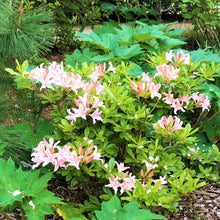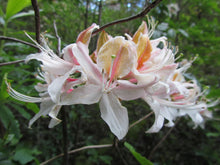Rhododendron occidentale
Western azalea is a gorgeous large shrub, the centerpiece in spring woodland gardens. In April or May, it explodes into bloom with five to fifteen sparkling white or pink, flaring trumpet-shaped flowers per branch, which can be delightfully-scented both sweet and spicy. The foliage emerges a bright shiny green; and graduates to golden yellow, though orange and deep scarlet also occur in autumn before the leaves drop for the winter. It is one of only two species of rhododendron native to the West Coast of North America.
- Plant type/canopy layer: large deciduous shrub
- Size at maturity: 2-20' tall, 8-10' wide
- Light requirements: part sun/part shade
- Moisture requirements: moist soil
- Bloom time: April - August (April - June in the Portland Metro area)
- Growth rate/ease: medium growth rate, easy to grow in the right conditions
- Wildlife support: flowers attract and provide nectar to hummingbirds, adult butterflies, bees and other insect pollinators
- Native habitat/range: locally common in moist thickets, seeps, ocean bluffs, edges of streams, and wet places along the edges of conifer forests, from sea level to 1400m, primarily west of the Cascades from central Oregon to northern California. Portland Plant List - no.
- Special features & uses: hummingbird favorite; extremely showy, fragrant flowers; landscape uses include pollinator gardens, woodland gardens, erosion control and habitat hedgerows
Gardening with Western Azalea: Typically found at higher altitudes, this shrub grows well in Portland-Metro area gardens, but requires ideal conditions to look its best, the longest. Plant it in a place that gets sun for much of the day, but where some shade protects it from harsh late-afternoon summer rays. It prefers soils that are acidic, moist and high in organic matter, such as pine needles, leaf litter and rotting wood. If it's not planted in a perennially moist place, be prepared to provide supplemental water in the summer drought (i.e. deep, infrequent water, no more than once per week).
Also note, Azalea species are the sole host to lace bugs (Stephanitis pyrioides). Lace bugs are native to Japan and were first documented in Oregon in 2009. This insect can dramatically affect the esthetic appearance of plants by sucking the chlorophyll out of leaves, damaging their ability to make nutrients from sunlight and making them appear sickly and pale. That said, the damage is usually just aesthetic and peaks at the end of the growing season and/or if the plant is stressed as a result of not being planted in the right conditions. Plus, in a natural garden full of insects, lace bugs can usually be effectively kept in check by natural predators including parasitic wasps, predatory assassin bugs, lacewing larvae, lady beetles, jumping spiders, pirate bugs, and mites. In Sparrowhawk's garden (where this photo was taken) some lace bug damage is visible by late summer, but it bounces back gorgeously each spring.
Photo Credit 1: Nikkie West, Sparrowhawk Native Plants
Photo Credit 2: "Rhododendron occidentale, Santa Cruz County" by theforestprimeval is licensed under CC BY-SA 2.0




